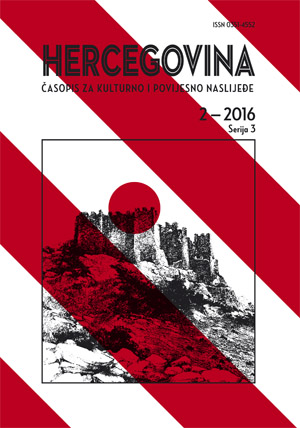Majića gradina (Drinovci) - novo nalazište licenske keramike u Hercegovini
The Majic hillfort (Drinovci) - a new finding site of the Litzen ceramics in Herzegovina
Author(s): Tino TomasSubject(s): Archaeology, Local History / Microhistory, Ancient World
Published by: Filozofski fakultet Sveučilišta u Mostaru
Keywords: the Majic hillfort; litzen and schnur ceramics; the Posusje culture; the Bronze Age; Drinovci; Herzegovina.
Summary/Abstract: The Majic hillfort (k. 478) is located in Drinovci, the Municipality of Grude. According to documented basic field data, such as natural position, topography and preserved elements of architecture, the hillfort fits into the category of hillforts, which makes one of the more prominent forms of Bronze Age in the East Adriatic cultural region. During reconnaissance of a wide area of the Majic hillfort, in its northern part with isolated artificial plateau a variety of fragments of pottery vessels were found. Most of the collected fragments are atypical, without elements that would serve their accurate cultural and chronological attribution. But one fragment stands out above all by its ornamental characteristics, a vessel neck fragment decorated with impressed complex textile pattern. Its macroscopic analysis shows a decorating technique which includes impression of twisted double cords (newer version of decorating schnur technique). The motifs include a combination of corrugated and horizontally laid prints. In the observed cultural region, such decorations are closely related to Litzen technique of decoration. In the analysis of primarily ornamental features of the observed fragments we find its closest analogy to the Posusje culture, precisely its Sovici phase (the site known as a Triple hillfort). Chronologically, it refers to the second half of the Early and the beginning of the Middle Bronze Age (Reinecke: Br. A2 - Br. B1). Further evidence that favors the setting of a relative chronological frame was obtained in the exploration of multilayer sites Pod A2 and Varvara A3. Original basic Litzen decorating technique cannot be verified within the cultural space of the region. It is therefore assumed that it was brought from the north, i.e. from its indigenous space. As the most likely direction of the Litzen decoration spreading to the south is the north-south direction, while we currently do not have enough reliable data on the reconstruction of the mechanisms and the nature of the Litzen decoration spread, due to a find is without stratigraphic confirmation. Thanks to a priori its ornamental characteristics, the analyzed fragment is a strong and reliable chronological landmark in the observed cultural region.
Journal: Hercegovina. Časopis za kulturno i povijesno naslijeđe (Do 2018)
- Issue Year: 2016
- Issue No: 2
- Page Range: 7-23
- Page Count: 17
- Language: Croatian

